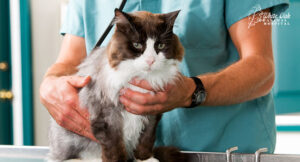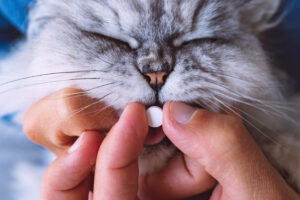
Understanding how to treat urinary tract infections in cats starts with recognizing the causes and symptoms. UTIs in cats are typically caused by bacteria entering the urinary tract, but other factors such as stress, dehydration, or bladder stones can also contribute. Urinary tract infections (UTIs) in cats are a common health issue that can cause significant discomfort and lead to more severe complications if not treated promptly.
Common symptoms include frequent urination, straining while urinating, and blood in the urine. Early detection is crucial for effective treatment, as untreated UTIs can lead to kidney infections or other serious conditions. Knowing how to treat urinary tract infections in cats can help prevent these complications and ensure your cat remains healthy and comfortable.
Understanding How to Treat a Urinary Tract Infection in Cats
Recognizing the symptoms of a urinary tract infection early is essential for effective treatment. When learning how to treat urinary tract infections in cats, it is important to understand the primary goals: relieving symptoms, eliminating the infection, and preventing future occurrences. Early intervention can reduce the risk of complications and improve your cat’s overall health. A proper diagnosis is crucial before starting any treatment for a urinary tract infection in cats.
 This often involves a thorough veterinary examination, including a urinalysis and possibly a urine culture, to identify the specific bacteria causing the infection. This helps determine the most effective treatment plan. Without a precise diagnosis, treatment may be less effective or even counterproductive. Understanding how to treat urinary tract infections in cats involves a combination of medical intervention, lifestyle adjustments, and preventive measures to ensure a full recovery and reduce the chances of recurrence.
This often involves a thorough veterinary examination, including a urinalysis and possibly a urine culture, to identify the specific bacteria causing the infection. This helps determine the most effective treatment plan. Without a precise diagnosis, treatment may be less effective or even counterproductive. Understanding how to treat urinary tract infections in cats involves a combination of medical intervention, lifestyle adjustments, and preventive measures to ensure a full recovery and reduce the chances of recurrence.
5 Proven Methods That Work for Treating Urinary Tract Infection in Cats
Antibiotic Therapy
Antibiotics are often the primary treatment for bacterial urinary tract infections in cats. When learning how to treat urinary  tract infections in cats, antibiotics play a crucial role in eliminating the bacteria causing the infection. A veterinarian will prescribe antibiotics based on the results of a urine culture and sensitivity test, which identifies the specific bacteria present and determines the most effective antibiotic to use.
tract infections in cats, antibiotics play a crucial role in eliminating the bacteria causing the infection. A veterinarian will prescribe antibiotics based on the results of a urine culture and sensitivity test, which identifies the specific bacteria present and determines the most effective antibiotic to use.
It is vital to follow the veterinarian’s instructions carefully and complete the full course of antibiotics, even if the symptoms seem to improve. This ensures that the infection is fully eradicated and helps prevent the development of antibiotic-resistant bacteria. Understanding the importance of antibiotics in treating urinary tract infections in cats can help pet owners manage their cat’s health more effectively and avoid complications from incomplete treatment.
Increasing Hydration
Hydration is a key factor in how to treat urinary tract infections in cats. Proper hydration helps flush out bacteria from the urinary tract, supporting overall urinary health and preventing the recurrence of infections. Encouraging your cat to drink more water is essential. Using a water fountain can make drinking more appealing, as cats are often attracted to running water.
Incorporating wet food into your cat’s diet can also increase water intake, providing additional moisture to help keep the urinary tract clean. Maintaining hydration is not only crucial for treating existing infections but also plays a preventative role in how to treat urinary tract infections in cats. Keeping your cat well-hydrated can reduce the likelihood of future infections, ensuring better long-term health.
Dietary Changes
 Dietary adjustments are an important part of how to treat urinary tract infections in cats. A specialized diet can help manage urinary health and prevent the formation of urinary crystals and stones, which are common causes of UTIs. Prescription diets are specifically formulated to support urinary health by regulating mineral content and pH levels in the urine, reducing the risk of crystal and stone formation.
Dietary adjustments are an important part of how to treat urinary tract infections in cats. A specialized diet can help manage urinary health and prevent the formation of urinary crystals and stones, which are common causes of UTIs. Prescription diets are specifically formulated to support urinary health by regulating mineral content and pH levels in the urine, reducing the risk of crystal and stone formation.
These diets can aid in both the treatment and prevention of UTIs by promoting a healthy urinary environment. Consulting with your veterinarian about the best dietary options is essential when considering how to treat urinary tract infections in cats. A tailored diet plan can significantly impact your cat’s recovery and help prevent future urinary issues, contributing to overall well-being.
Natural Supplements and Remedies
Natural supplements and remedies like Dr. Damron’s PET | TAO Soothe Bladder Supplement can be an effective addition to traditional treatments when considering how to treat urinary tract infections in cats. Supplements like cranberry extract and D-mannose are known to support urinary health by preventing bacteria from adhering to the urinary tract walls. Herbal remedies such as marshmallow root and uva ursi can also soothe the urinary tract, reducing inflammation and discomfort.
These natural options can provide additional support in managing urinary health and preventing the recurrence of infections. However, it is important to consult with a veterinarian before starting any natural supplements, as they can interact with other medications or may not be suitable for all cats. Incorporating natural supplements into the treatment plan can enhance the overall approach to how to treat urinary tract infections in cats, providing a holistic method that supports both recovery and prevention.
Stress Reduction Techniques
 Stress can play a significant role in urinary tract health, making stress reduction an essential component of how to treat urinary tract infections in cats. Stress can cause changes in a cat’s behavior and physiology, potentially leading to urinary issues. Techniques to reduce stress include creating a calm and stable environment, providing enrichment activities like toys and interactive play, and ensuring your cat has a safe and comfortable space to retreat to.
Stress can play a significant role in urinary tract health, making stress reduction an essential component of how to treat urinary tract infections in cats. Stress can cause changes in a cat’s behavior and physiology, potentially leading to urinary issues. Techniques to reduce stress include creating a calm and stable environment, providing enrichment activities like toys and interactive play, and ensuring your cat has a safe and comfortable space to retreat to.
Stress-reducing products, such as pheromone diffusers, can also help create a more relaxed atmosphere. By minimizing stress, you can prevent the recurrence of urinary tract infections and support overall health. Understanding the connection between stress and urinary health is crucial for a comprehensive approach to how to treat urinary tract infections in cats. Reducing stress not only aids in the treatment of current infections but also helps prevent future episodes, ensuring a happier, healthier cat.
When to Seek Veterinary Care
Knowing when to seek veterinary care is crucial in learning how to treat urinary tract infections in cats. Immediate veterinary attention is needed if your cat shows severe symptoms, such as blood in the urine, straining to urinate, or displaying signs of pain. These symptoms can indicate a serious infection that may require prompt medical intervention to prevent complications like kidney infections. Regular veterinary check-ups are also important for cats prone to urinary issues, as early detection and treatment can prevent more severe health problems.
Additionally, if your cat has been treated for a UTI but symptoms persist or recur, a follow-up visit to the vet is essential. This helps ensure the infection has been fully eradicated and allows for adjustments to the treatment plan if necessary. Seeking timely veterinary care is a vital part of how to treat urinary tract infections in cats effectively and safeguard their long-term health.
Prevention Tips to Avoid Urinary Tract Infections in Cats
Preventing urinary tract infections is as important as knowing how to treat urinary tract infections in cats. Practical steps include maintaining proper litter box hygiene, ensuring fresh water is always available, and encouraging hydration through wet food or water fountains. A balanced diet that supports urinary health is crucial, as are regular veterinary check-ups to monitor and manage any underlying conditions that could predispose your cat to UTIs.
Preventive measures can save time, money, and stress by reducing the likelihood of recurrent infections and ensuring your cat stays healthy. Being proactive in your approach to urinary health is a key component of how to treat urinary tract infections in cats and can significantly enhance your pet’s quality of life.
 Understanding how to treat urinary tract infections in cats involves recognizing symptoms early and seeking prompt veterinary care to ensure effective treatment. Early intervention is essential to prevent complications and ensure a quick recovery. At White Oak Animal Hospital, we offer comprehensive care and specialized treatment options for urinary tract infections in cats, including advanced diagnostic tools and personalized treatment plans.
Understanding how to treat urinary tract infections in cats involves recognizing symptoms early and seeking prompt veterinary care to ensure effective treatment. Early intervention is essential to prevent complications and ensure a quick recovery. At White Oak Animal Hospital, we offer comprehensive care and specialized treatment options for urinary tract infections in cats, including advanced diagnostic tools and personalized treatment plans.
Our integrative approach, which combines conventional veterinary medicine with holistic options like TCVM Telemedicine consultations, sets us apart. With over 28 years of experience, White Oak Animal Hospital provides unparalleled expertise in managing feline urinary health. Our team is dedicated to helping your pet achieve a full recovery while preventing future issues.
If you suspect your cat has a urinary tract infection or want to learn more about preventive care, contact White Oak Animal Hospital today to schedule a consultation. We are here to support you and your pet with compassionate care and expert guidance.
Frequently Asked Questions
What are the early signs of a UTI in cats?
Early signs of a UTI in cats include frequent urination, straining to urinate, and visible discomfort while urinating. You may also notice blood in the urine or your cat crying out in pain during bathroom visits. Changes in litter box habits, such as urinating outside the box, can also indicate a problem. If you observe any of these symptoms, it’s crucial to consult a veterinarian immediately. Early detection of how to treat urinary tract infections in cats can lead to more effective treatment and quicker recovery.
Can a UTI in cats clear up without antibiotics?
Most urinary tract infections in cats require antibiotics to eliminate the bacteria causing the infection. While some mild cases might resolve on their own, this is rare and risky. Untreated UTIs can lead to more severe complications, such as kidney infections or bladder stones. Natural remedies and supplements may support recovery but should not replace antibiotics unless directed by a veterinarian. Understanding how to treat urinary tract infections in cats effectively typically involves a combination of antibiotics and supportive care to ensure complete recovery and prevent recurrence.
How can I prevent my cat from getting recurring UTIs?
Preventing recurring UTIs in cats involves several strategies, including maintaining a clean litter box, providing fresh water, and feeding a balanced diet designed for urinary health. Reducing stress through environmental enrichment and regular veterinary check-ups is also crucial. Regular monitoring and early intervention can help prevent the development of more severe infections. Understanding how to treat urinary tract infections in cats goes hand-in-hand with knowing how to prevent them, ensuring your cat remains healthy and comfortable.
Are certain cats more prone to UTIs than others?
Yes, factors like age, breed, and underlying health conditions can make some cats more susceptible to UTIs. Older cats and those with diabetes or kidney issues are particularly at risk. Regular veterinary check-ups are essential for monitoring and managing these risk factors effectively.
Related Posts
-
How to Treat a Cat UTI At Home
A cat UTI is more common in female cats than male cats. However, male cats…
-
Top 5 Ways to Treat Dog Nail Infections: Stop the Pain Now
Dog nail infections are a common yet often overlooked health issue that can cause significant…
-
The $600 Hairball (And How to Prevent It): How to Treat Hairballs in Cats
Why Learn How to Treat Hairballs in Cats? If you own cats, you’ve probably dealt…
-
Easy Cat UTI Prevention
Cat UTI prevention is simple once you understand the root cause. Your veterinarian can help…









